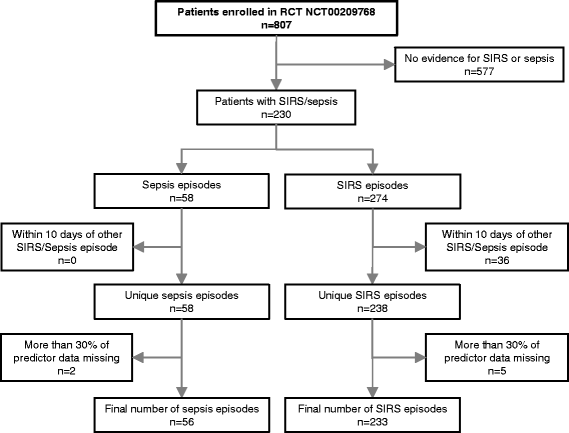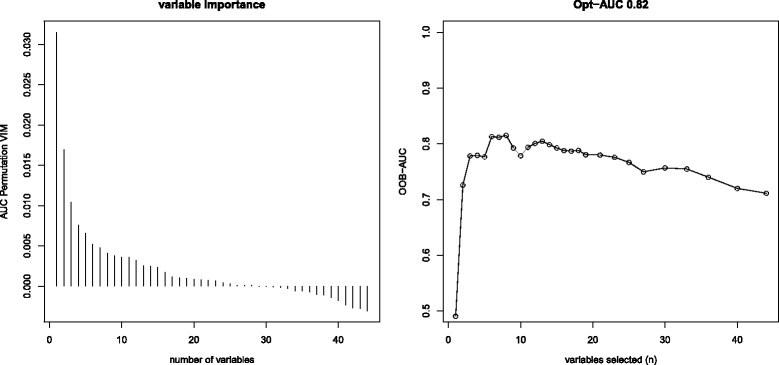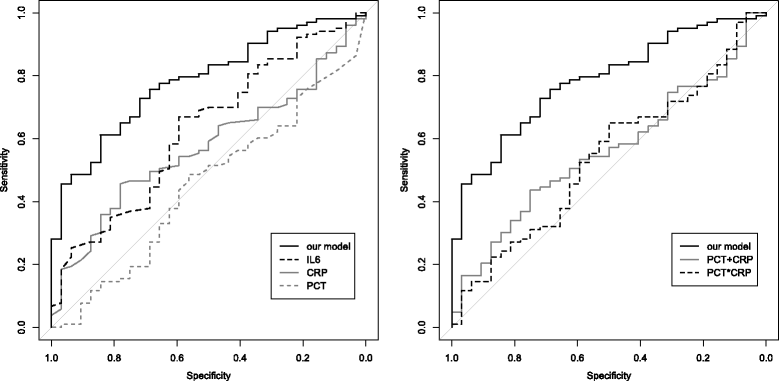Development and validation of a diagnostic model for early differentiation of sepsis and non-infectious SIRS in critically ill children - a data-driven approach using machine-learning algorithms
- PMID: 29544449
- PMCID: PMC5853156
- DOI: 10.1186/s12887-018-1082-2
Development and validation of a diagnostic model for early differentiation of sepsis and non-infectious SIRS in critically ill children - a data-driven approach using machine-learning algorithms
Abstract
Background: Since early antimicrobial therapy is mandatory in septic patients, immediate diagnosis and distinction from non-infectious SIRS is essential but hampered by the similarity of symptoms between both entities. We aimed to develop a diagnostic model for differentiation of sepsis and non-infectious SIRS in critically ill children based on routinely available parameters (baseline characteristics, clinical/laboratory parameters, technical/medical support).
Methods: This is a secondary analysis of a randomized controlled trial conducted at a German tertiary-care pediatric intensive care unit (PICU). Two hundred thirty-eight cases of non-infectious SIRS and 58 cases of sepsis (as defined by IPSCC criteria) were included. We applied a Random Forest approach to identify the best set of predictors out of 44 variables measured at the day of onset of the disease. The developed diagnostic model was validated in a temporal split-sample approach.
Results: A model including four clinical (length of PICU stay until onset of non-infectious SIRS/sepsis, central line, core temperature, number of non-infectious SIRS/sepsis episodes prior to diagnosis) and four laboratory parameters (interleukin-6, platelet count, procalcitonin, CRP) was identified in the training dataset. Validation in the test dataset revealed an AUC of 0.78 (95% CI: 0.70-0.87). Our model was superior to previously proposed biomarkers such as CRP, interleukin-6, procalcitonin or a combination of CRP and procalcitonin (maximum AUC = 0.63; 95% CI: 0.52-0.74). When aiming at a complete identification of sepsis cases (100%; 95% CI: 87-100%), 28% (95% CI: 20-38%) of non-infectious SIRS cases were assorted correctly.
Conclusions: Our approach allows early recognition of sepsis with an accuracy superior to previously described biomarkers, and could potentially reduce antibiotic use by 30% in non-infectious SIRS cases. External validation studies are necessary to confirm the generalizability of our approach across populations and treatment practices.
Trial registration: ClinicalTrials.gov number: NCT00209768; registration date: September 21, 2005.
Keywords: Diagnosis; Intensive care unit; Pediatric; Random Forest; SIRS; Sepsis.
Conflict of interest statement
Ethics approval and consent to participate
Ethics approval was obtained from the ethics committee of Hannover Medical School (3702/2005). All legal guardians provided written informed consent on admission to PICU.
Consent for publication
Not applicable.
Competing interests
FL, NR, PB, RTM and AK report no conflicts of interest. MS, TJ and MB report having been paid travel and lecture fees from Pall Corporation and B. Braun Corporation.
Publisher’s Note
Springer Nature remains neutral with regard to jurisdictional claims in published maps and institutional affiliations.
Figures



Similar articles
-
Role of soluble triggering receptor expressed in myeloid cells-1 in distinguishing SIRS, sepsis, and septic shock in the pediatric intensive care unit.Arch Pediatr. 2021 Oct;28(7):567-572. doi: 10.1016/j.arcped.2021.06.001. Epub 2021 Aug 13. Arch Pediatr. 2021. PMID: 34393025
-
Soluble CD14 subtype (sCD14-ST) presepsin in premature and full term critically ill newborns with sepsis and SIRS.Clin Chim Acta. 2015 Dec 7;451(Pt A):65-70. doi: 10.1016/j.cca.2015.07.025. Epub 2015 Jul 29. Clin Chim Acta. 2015. PMID: 26232159
-
Procalcitonin and C-reactive protein as markers of systemic inflammatory response syndrome severity in critically ill children.Intensive Care Med. 2007 Mar;33(3):477-84. doi: 10.1007/s00134-006-0509-7. Epub 2007 Jan 27. Intensive Care Med. 2007. PMID: 17260130
-
Clinical Decision-Support Systems for Detection of Systemic Inflammatory Response Syndrome, Sepsis, and Septic Shock in Critically Ill Patients: A Systematic Review.Methods Inf Med. 2019 Dec;58(S 02):e43-e57. doi: 10.1055/s-0039-1695717. Epub 2019 Sep 9. Methods Inf Med. 2019. PMID: 31499571
-
Clinical laboratory differentiation of infectious versus non-infectious systemic inflammatory response syndrome.Clin Chim Acta. 2005 Jan;351(1-2):17-29. doi: 10.1016/j.cccn.2004.08.018. Clin Chim Acta. 2005. PMID: 15563869 Review.
Cited by
-
Novel Biomarkers Differentiating Viral from Bacterial Infection in Febrile Children: Future Perspectives for Management in Clinical Praxis.Children (Basel). 2021 Nov 20;8(11):1070. doi: 10.3390/children8111070. Children (Basel). 2021. PMID: 34828783 Free PMC article. Review.
-
Role of Artificial Intelligence in Fighting Antimicrobial Resistance in Pediatrics.Antibiotics (Basel). 2020 Nov 1;9(11):767. doi: 10.3390/antibiotics9110767. Antibiotics (Basel). 2020. PMID: 33139605 Free PMC article. Review.
-
Evaluating the factors influencing accuracy, interpretability, and reproducibility in the use of machine learning classifiers in biology to enable standardization.Sci Rep. 2025 May 13;15(1):16651. doi: 10.1038/s41598-025-00245-6. Sci Rep. 2025. PMID: 40360553 Free PMC article.
-
Comparison of Random Forest and Stepwise Regression for Variable Selection Using Low Prevalence Predictors: A case Study in Paediatric Sepsis.Matern Child Health J. 2025 May;29(5):604-613. doi: 10.1007/s10995-025-04038-1. Epub 2025 Jan 15. Matern Child Health J. 2025. PMID: 39812888 Free PMC article.
-
Updates on pediatric sepsis.J Am Coll Emerg Physicians Open. 2020 Jul 3;1(5):981-993. doi: 10.1002/emp2.12173. eCollection 2020 Oct. J Am Coll Emerg Physicians Open. 2020. PMID: 33145549 Free PMC article. Review.
References
-
- Bone RC, Balk RA, Cerra FB, Dellinger RP, Fein AM, Knaus WA et al. American-College of Chest Physicians Society of Critical Care Medicine Consensus Conference - Definitions for Sepsis and Organ Failure and Guidelines for the Use of Innovative Therapies in Sepsis. Crit Care Med. 1992;20:864–74. - PubMed
-
- Kumar A, Roberts D, Wood KE, Light B, Parrillo JE, Sharma S, Suppes R, Feinstein D, Zanotti S, Taiberg L, et al. Duration of hypotension before initiation of effective antimicrobial therapy is the critical determinant of survival in human septic shock. Crit Care Med. 2006;34:1589–1596. doi: 10.1097/01.CCM.0000217961.75225.E9. - DOI - PubMed
Publication types
MeSH terms
Associated data
LinkOut - more resources
Full Text Sources
Other Literature Sources
Medical
Research Materials
Miscellaneous

